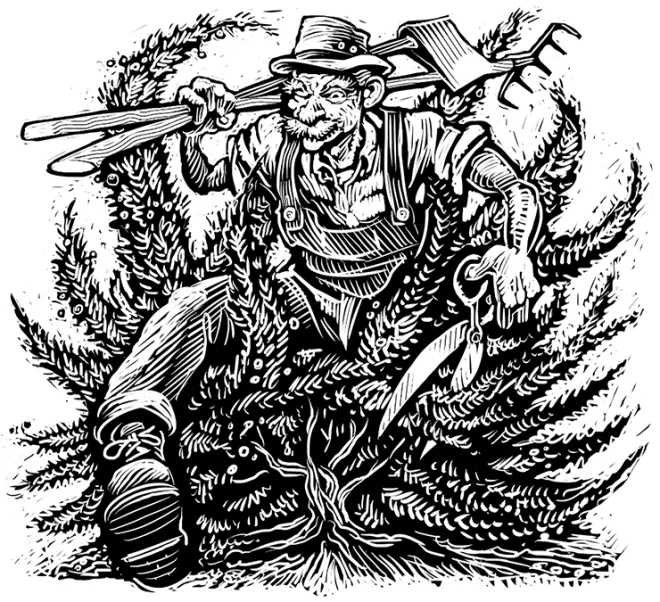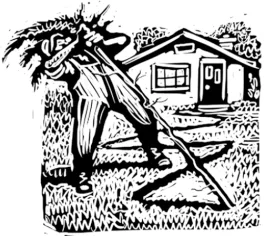
Though gardeners never lack for companions, I fear that all too many are short on curmudgeons. It doesn’t take long to figure out why. While companions are sunny, hearty characters who compliment your color choice of petunias and assure you there is no more chance of spring frost, a curmudgeon will notify you that a late winter storm is just around the corner. While a companion assures you that the periwinkle will remain firmly fixed within its borders, the curmudgeon will remind you what happened to the Siberian squill the last time you believed such a lie.
In short, while companions make everyone feel better, it’s the curmudgeon who ensures the proverbial wool remains firmly fixed above the brow. And while it’s true nobody particularly enjoys the company of a curmudgeon for long, most will admit we feel safer when they’re around.
Even a wary sniff will tell you the attached thousand-word tirade is sourced from 100% pure, uncut curmudgeon.
Consider yourself warned.
I often wonder why homeowners insist on cultivating a front garden at all, since so few approach the subject with anything resembling relish. Typical exhibits will include: 1) no more than two emerald cedars, anemic if possible, 2) a haggard barberry perimeter, and 3) several suspicious-looking junipers lurking in the shadows.
Except for the juniper, toward which I maintain rabid prejudice, I’ve nothing against these specimens in particular. But to enlist such a dishevelled cohort as a home’s welcoming committee? These tired displays have become little more than clichés—something “thrown out there” when there’s nothing else to say, never failing to inspire polite nods, nervous coughs, and sudden recollections of a missed dentist appointment.
What enables this phenomenon to persist? Do neighborhood committees draw up contracts stating: “Local residents henceforth pledge themselves to maintain as threadbare a plot as conscience and local bylaws will allow?”
Still, it is not here my intention to dilute such long-nurtured ire on this disturbing “front garden” trend as a whole. No, I would prefer to dump the entire brew on that particularly loathsome spawn of the Juniperis genus—J. communis. I ’m aware of the controversial implications of this opinion, as these shrubs have become the trusty sidearm of that brand of horticulture unhindered by aesthetic sensibilities. Nevertheless, few subjects inspire such personal misery as the popularity of the aforementioned blue-green horror.
Why do I rage against this humble conifer?
Though Juniperis appears around the world in a notable array of variety (one study deduces nearly 67 species), you will find the North-American model arrives looking as if it had been shampooed sans conditioner and then dried vigorously with a wire brush. This affords the juniper its one true delight in this world, which is to savage the arms, legs, and face of any caregiver within branch’s reach. And these are but the first fruits of your incredibly long journey with this sociopathic shrub.
Like a recently enrolled college student, the juniper is entirely unable to live within its means and will waste no time invading the personal space of every specimen within a five-foot radius. While you may find some initial entertainment in a grappling match between it and a hapless sand cherry, decency will demand you eventually step in and separate the two, awarding the former a constructive smack and a “Don’t make me get the shears.” Of course, this will only encourage them because junipers not only tolerate but positively revel under abuse and neglect. They can dish it out just as well—any attempt at nurturing, fertilizing, or complimenting will be met with severe lacerations.
Speaking of pruning, at some point you will be forced into the unenviable position of having to trim it back. Let the thing spread and it will stop at nothing less than the naturalization of the entire neighbourhood; hack it back and you run the risk of a citizen’s arrest for hedge abuse. You may as well accept the fact that there will be no winner in this contest. You are fixed firmly on the nasty little thorns of a dilemma.
The uses for juniper are, unsurprisingly, very few. One can always resort to culinary forays—berries can either be pulverized to make a passable glaze for bear sausage (I imagine the bitterness disguises the gaminess quite effectively) or added to high-proof alcohol to impart that distinctive gin flavor so prized by grandmothers.
Alternatively, you may find yourself at a particularly stressful juncture in life and discover the delicate art of juniperis bonsai to be an effective means of decompression. (I imagine the opportunity to slowly deconstruct a juniper would be therapeutic.)
Their final use may best be appreciated by alluding to the practice of adding things like feathers and corncobs to frozen meat nuggets in order to increase bulk. In a similarly grotesque fashion, one may thrust large specimens of J. communis into mass hedge plantings to eliminate unsightly gaps while, supposedly, increasing textural interest—for those individuals who find such texture sleuthing a compelling prospect. The hope is that the more leafy flotsam one stuffs around a juniper, the easier it will be to forget about it and get back to your life.
Unhindered, the juniper will likely outlive both you and your descendants. This is good news because its final cycle of life amounts to a suspended state of mange. Exposed, arthritic roots and bleak patches of brown will notify you of this mid-to-end-life crisis, but be aware it will probably exist in this gnarled virility until someone decides to roll down their sleeves (not up, you know, because it’s a juniper) and put the poor thing out of our misery.
Before I had the privilege of excavating several junipers that had passed the point of no return, I found myself wondering if they were as ugly underneath as they were above the ground. I was not disappointed. You remember that game you played as children where you followed the string around the house until you found the prize at the end? Well, ripping out a juniper is like that, only there’re a dozen different strings and, instead of a prize, all of them end in about two years off your life.

John Prine once crooned that while old people tend to grow lonely, old trees just grow stronger. The common juniper is, if nothing else, living credence to this adage. Perhaps against the backdrop of our own relative fragility we find such curious comfort in its enduring legacy—ever aging, ever more obstreperous.
Is the juniper thus as much of a curmudgeon as I am? Ahem. How could you even think of such a comparison? ❖



